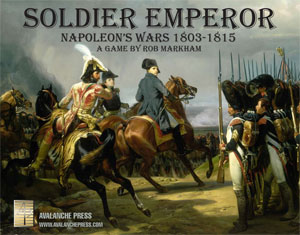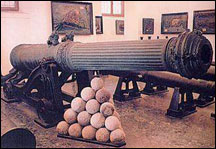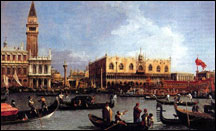| Soldier
Emperor:
Venice Unleashed
By Mike Bennighof, Ph.D.
May 2019
 On 15 May 1797, French soldiers entered
Venice to officially put an end to the Republic.
No foreign army had ever set foot in the city
before, and Ludovico Manin, the 120th and
last doge, quietly gave way to a municipal
government everyone knew to be the puppet
of the French commander in Italy, Napoleone
Buonaparte. Later that year, having thoroughly
looted the proud city of cash, artwork and
other treasures, the French handed Venice
over to Austrian rule. On 15 May 1797, French soldiers entered
Venice to officially put an end to the Republic.
No foreign army had ever set foot in the city
before, and Ludovico Manin, the 120th and
last doge, quietly gave way to a municipal
government everyone knew to be the puppet
of the French commander in Italy, Napoleone
Buonaparte. Later that year, having thoroughly
looted the proud city of cash, artwork and
other treasures, the French handed Venice
over to Austrian rule.
It was a sad end to a long history. Usually
outnumbered and outgunned by its adversaries,
for centuries the Serene Republic had used
astute diplomacy and commercial cunning to
maintain its power. By the 18th century, its
trading families had instead invested their
profits in safe agricultural ventures on the
mainland, while the city’s major asset
became its justly-famed courtesans. Visitors
poured into Venice to sample its sexual and
other entertainments, but the Republic’s
power steadily declined.

Venetian firepower, from an earlier,
grander age.
|
The Venetian Senate and Grand Council declared
itself neutral in the war between the French
revolutionaries and most of Europe, but showed
itself distinctly pro-Austrian when the fighting
spread to northern Italy. Yet Venice did little
to strengthen its armed forces, even after playing
host to the Comte de Lille, pretender to the
French throne. In the Senate, Francesco Pesaro
argued strenuously that neutrality could only
be defended with strength. Other Senators pointed
out that such rearmament would mean taxes on
the Republic’s wealthiest families, something
they would not tolerate. And recruiting troops
might antagonize France, Austria, or both.
Not until 1796, following Buonaparte’s
strong of victories in Italy, did the Senate
take Pesaro’s warnings seriously. In
June, the fleet was ordered home from Corfu
and placed on full mobilization — only
11 small and terribly obsolete warships were
found fit for service. New ships would take
time to build; despite the Senate’s
fears, the Grand Council secretly ordered
a new program since shipbuilding could easily
be hidden with the Arsenal. Under an open threat from the French,
Venice backed down on army mobilization. Yet
when offered an alliance by the French, the
Venetians spurned Buonaparte.

Venetian artillerymen of the previous
century.
|
Not until French incursions sparked revolts
in the mainland cities of Brescia and Bergamo
did Venice begin to arm, putting 10,000 men
into the field in early 1797. Taking this
as a provocation, the French occupied Verona
and other cities. In April, the Veronese rose
against the French and a Venetian fortress
shot up a French warship. Infuriated, or at
least making a pretense of fury, Buonaparte
demanded the Republic’s abject surrender.
After only brief discussion, the Senate crumbled.
The Serene Republic was destroyed.
Venice had considerable military potential.
Its regular forces numbered about 5,000 in
1795; traditionally most were Croats recruited
in Dalmatia. The Republic’s wealth and
population base could easily have supported
a regular army many times that size. Assuming,
of course, that the rich would pay to defend
their Republic.
Venice’s most important military asset,
the famous Arsenal, was Europe’s first
assembly line operation and in many ways provided
the model for the modern industrial age. Arsenalotti
manufactured galleys using a modular system
that would not be out of place in a 21-century
installation, under the firmest secrecy. As
Venice’s power waned and the oared galley
gave way to what Venetians called “fat”
ships, so did the Arsenal’s manufacturing
capability, but when the French entered in
1797 they found nearly a dozen 74-gun ships
of the line in various states of construction.
The secret nature of the new program meant
that the channel outside the Arsenal had not
been dredged; the big new ships could not
have been floated out without considerable
and very public effort. There’s also
no evidence that recruiting had begun for
crews, though the navy had considerable surplus
personnel aboard its watch vessels and useless
war galleys.

Venice’s Arsenal.
|
Though considered a quaint relic by many,
known mainly for the acrobatic performances
put on by its workers on holidays, the Arsenal
retained an enormous productive capacity.
When Napoleon began to rebuild his naval power
after Trafalgar and placed numerous orders
in Venice, the Arsenal quickly outstripped
French shipyards. Despite a steady decline
in the Republic’s seafaring, especially
after Venetian traders were allowed to lease
foreign vessels, the Queen of the Adriatic
still boasted a large number of able seamen
and experienced officers.
In our Soldier
Emperor game, there is no independent
Venice. But even in scenarios taking place
after the Republic’s fall, conquered
minor nations can be brought back into play
through the Liberation rule (18.3). And so
today we’re putting the Serene Republic
into the game.
Although Venezia begins the 1803 scenario
under Austrian control, France is the original
conqueror and thus forbidden from liberating
the Republic. Venice can only be restored
starting with Venezia, but other territories
can be added: Croatia, Corfu and Crete.
Venice has one army and three fleets. Only
one fleet may be built and in play unless
Croatia is part of the Republic, in which
case the other two fleets may be built. If
Croatia is subsequently lost, the fleets are
not removed from play, but may not be replaced
if lost as long as Croatia is not part of
Venice.
Venice’s alliance modifiers are:
- Britain: 0
- France: Prohibited
- Prussia: 0
- Austria: +2
- Russia: 0
- Spain: +1
- Turkey: +1
- Starting Forces: None
- Recovery Number: 1
You can download
the new Venetian playing pieces here.
Click
here to order Soldier
Emperor now!
Sign up for our newsletter right here. Your info will never be sold or transferred; we'll just use it to update you on new games and new offers.
Mike Bennighof is president of Avalanche Press and holds a doctorate in history from Emory University. A Fulbright Scholar and award-winning journalist, he has published over 100 books, games and articles on historical subjects.
He lives in Birmingham, Alabama with his wife, three children and his dog, Leopold.
|
